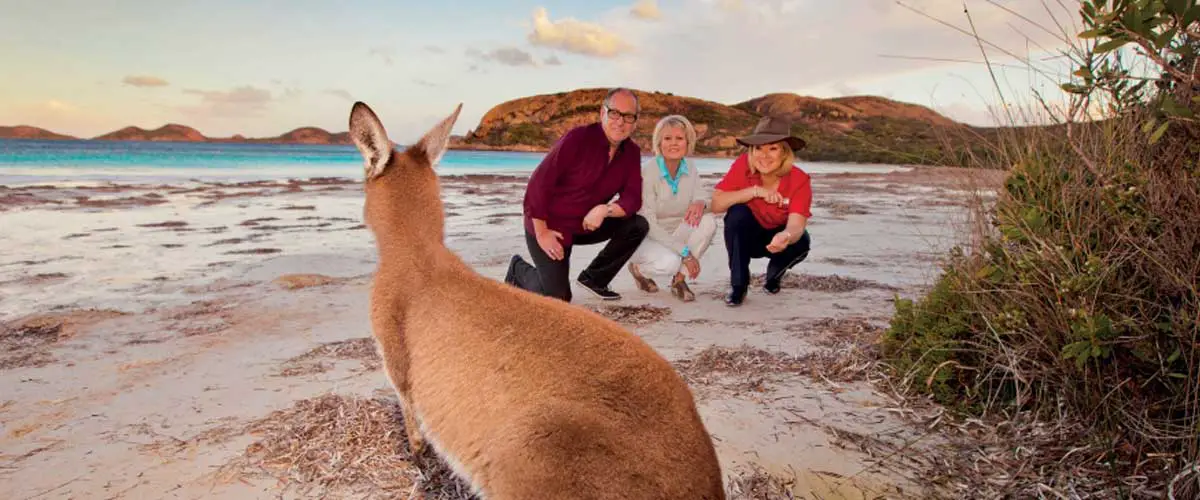The Eastern grey kangaroo is the most well known species of kangaroo, and can be found on the eastern coastlines of Australia, all of Queensland with the exception of western Cape York, New South Wales, and parts of Tasmania, most notably the north eastern portion.
Eastern grey kangaroos have a similar impact on the ecoystem as most other species of kangaroo. They are grazers and control the growth and spread of grass and other types of foliage. As with other grazers, this leads to soil dessication if unchecked, but their numbers are not great enough to be considered a serious ecological hazard. Eastern grey kangaroos live for about 7-10 years in the wild, while there are records of those in captivity that have lived in excess of 20 years.
The eastern grey kangaroo can often been seen in bushland, farmland and beside roads throughout its habitat – the eastern coastlines of Australia, all of Queensland with the exception of western Cape York, New South Wales, and parts of Tasmania, most notably the north eastern portion. As eastern grey kangaroos spend most of their day under the shade, then move out at dusk to feed until dawn, they can be a hazard when driving from dusk onwards. After rain, they can be particularly hazardous when they move to and from their grazing lands to pools of water by the roadside for a drink.
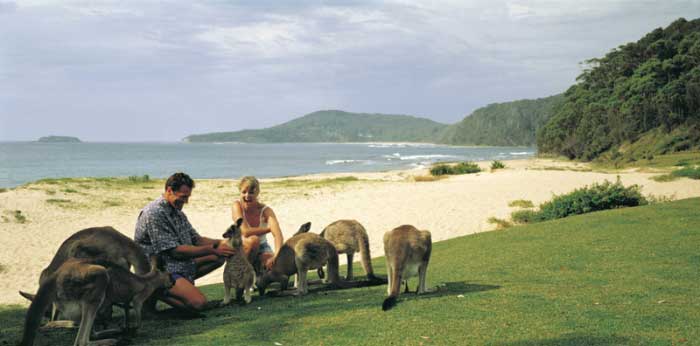
Pebbly Beach, NSW
The beach is one of the last places one expects to find kangaroos, and at the few beaches where kangaroos are known to frequent on a regular basis, their presence affords some wonderful photo opportunities. At Pebbly Beach in Murramarang National Park, near Batemans Bay, NSW, the local kangaroos not only graze on the grass above the beach and around the cabins, they often jump into the surf and splash around.
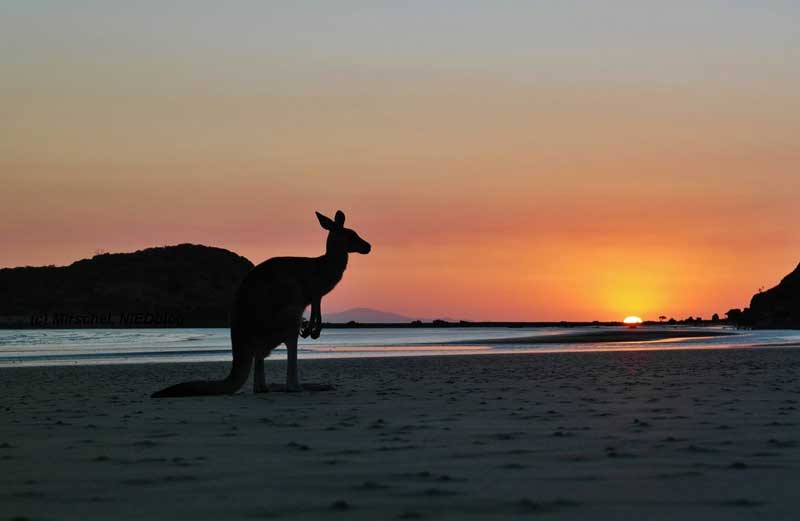
Cape Hillsborough, Qld
At Cape Hillsborough, Qld, eastern greys can often be found around the picnic areas and on the beach during the afternoon and evening, feeding on the washed up seaweed. A similar things occurs with western grey kangaroos on the other side of the continent near Esperance, WA. At Lucky Bay in Cape Le Grand National Park, seaweed accumulates in deep spongy masses and provides the interesting spectacle of a mob of local kangaroos descending to the beach of an evening to dine on fresh seaweed.
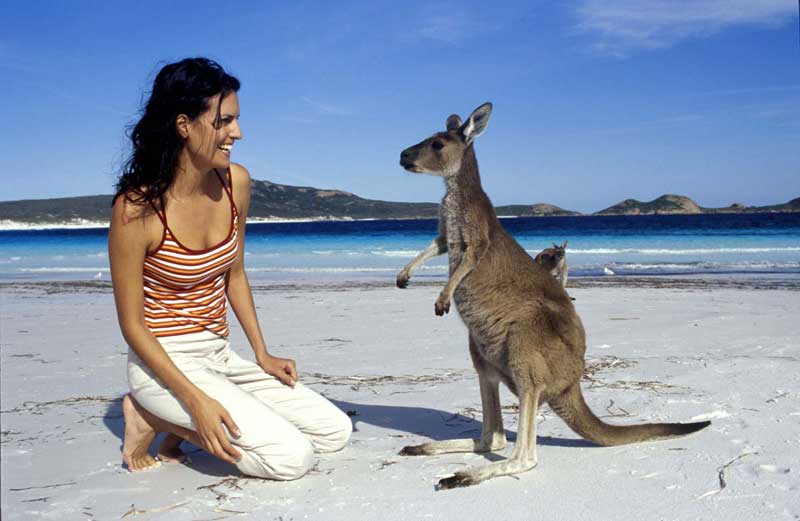
Lucky Bay, WA
At Pambula on the NSW south coast, the normally shy kangaroos graze unperturbed on grasses found around the town, particularly at the caravan park, in spite of human activity nearby, including cars and workers coming and going.
The 18-hole golf course at Anglesea, Vic., is set amidst native bushland, and is home to over three hundred untamed kangaroos, who graze the fairways daily. During early morning and late afternoon, flocks of between fifty and a hundred kangaroos invariably present a hazard to golfers on some fairways. Occasionally, golfers have struck kangaroos with golf balls on their drives, and on one notable occasion, a golfer landed a ‘hole-in-one’ into the pouch of a kangaroo, which nonchalantly hopped away with the ball still in its pouch! Kangaroos also frequent the fairways of the 18-hole golf course of Headland Golf Club at Golf links Road, Buderim, on Queensland’s Sunshine Coast
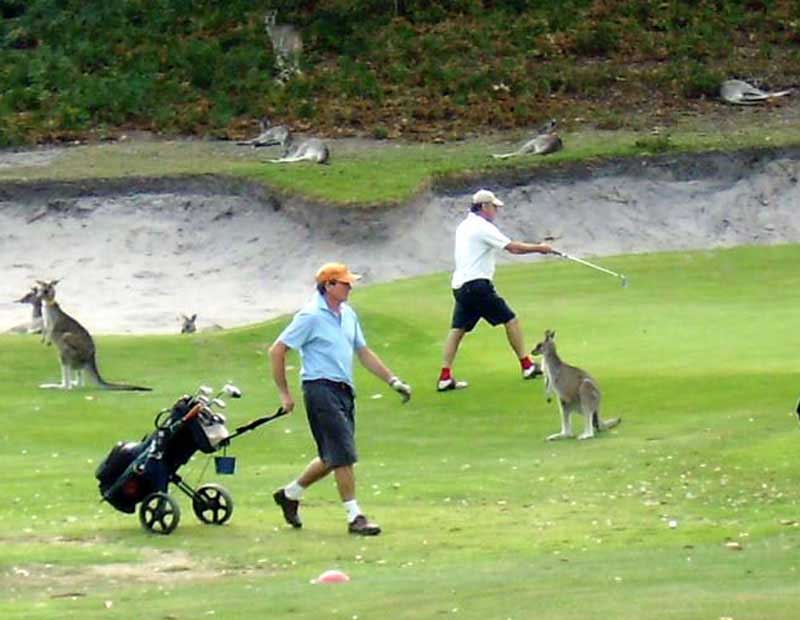
Anglesea Golf Course, Vic
Kangaroos and koalas are the most sought after species of Australian wildlife that overseas visitors want to see during a visit to Australia, so all zoos, wildlife parks and sanctuaries have plenty of kangaroos and wallabies to keep their visitors happy.
Eastern grey kangaroos are often confused with the western grey kangaroos, which were initially considered a subspecies of the eastern grey. While a stark contrast in fur col our can be seen in the throat and other areas of the western grey, eastern grey kangaroos have a more even distribution in fur col our. The faces of the two species differ in that the western grey has a darker complexion as opposed to the almost white face of the eastern grey. Eastern greys also lacks the white patch on the upper thigh which is characteristic of a western grey. There is great sexual dimorphism in size, with the males ranging from twice to three times the mass of an average female.
Eastern grey kangaroos on the coastline will usually exhibit lighter coloured fur than those inland, which are considerably darker in colour. Eastern greys in Tasmania and the southern portions of Queensland also exhibit longer fur than in other areas. One other identifying characteristic is the black tip on the tails of this species. Females usually weigh up to about 40 kg, while males can weigh over twice as much, up to 90 kg. The standard metabolic rates of both eastern grey kangaroos and western grey kangaroos are lower than eutherians, although eastern grey kangaroos have a lower standard metabolic rate than western grey kangaroos.
Eastern grey kangaroos inhabit a wide variety of habitats ranging from open woodlands to grasslands. They can also be found in mountains with extensive forest cover. The habitats of this species are usually areas of high rainfall, but this can also range to semi-arid areas.
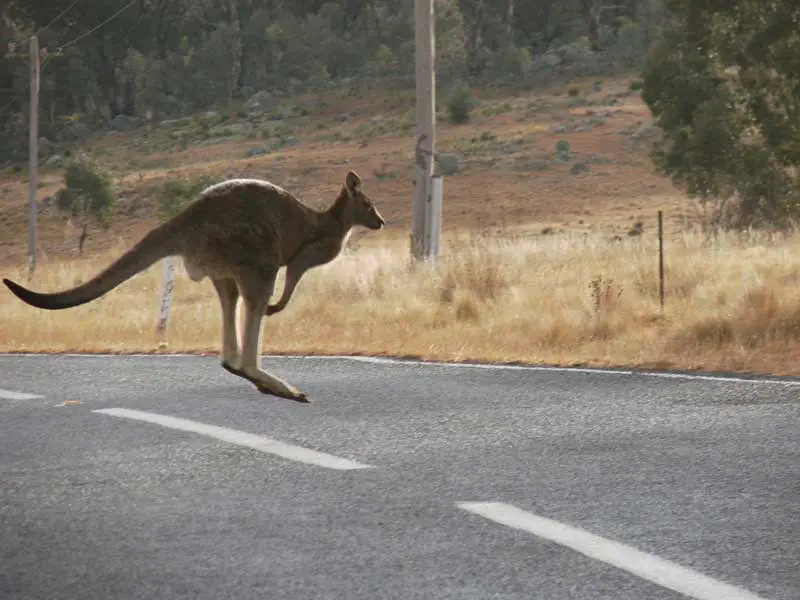
Eastern grey kangaroos are a social species and usually live in small groups called ‘mobs’. These ‘mobs’ include one dominant male, about 2-3 females with their young, and about 2-3 young males. As is common in all kangaroos, eastern greys move by hopping, usually around 9 meters every hop. Also characteristic of most kangaroos, the legs of eastern greys are designed so that they expend less energy the faster they are moving, which can be up to speeds of 30 miles per hour. Eastern grey kangaroos spend most of their day under the shade, then move out at dusk to feed until dawn. Male eastern grey kangaroos often ‘box’ or exhibit other types of aggressive behaviour to establish dominance. The dominant male is the most likely individuals to mate with a female in estrus. When a female eastern grey kangaroo reaches estrus, the male will approach and sniff various parts of her body including her pouch and urogenital area. He may also make clucking noises and paw her head and tail, a behaviour characteristic of many kangaroo species.
Eastern grey kangaroos are seasonal breeders (spring and early summer), unlike some kangaroo species such as the red kangaroo or even the closely related western grey kangaroo, which breeds continuously as long as the conditions are good.
A joey, or baby kangaroo, usually stays in the pouch for 11 months during which it feeds from its mother’s milk. It feeds for an additional 9 months, on average, from the mother’s milk, although it leaves the pouch at 11 months. During this time, the mother provides protection and food and also guidance as the joey comes closer to becoming fully independent.
Eastern grey kangaroos are grazers and eat a wide variety of foliage ranging from grasses to forbs (broad-leaved herbs besides grass that grow on plains and meadows). The main choice of food, however, is grass, which grows on the plains that these kangaroos usually inhabit. In captivity, eastern greys may also feed upon fruits, although this is not part of the usual diet in the wild.
There are almost 2 million eastern grey kangaroos in Australia and the surrounding areas, and thus, are not considered to be in any immediate danger of extinction. There was a sharp decline in the population of eastern grey kangaroos in the late 1990’s especially in Tasmania. However, these kangaroos are now protected by law by the Australian government and most of their range is now on private property. This has enabled the eastern grey kangaroo population to increase and continue growing. There is a large kangaroo industry in Australia but the number of kangaroos killed each year is strictly monitored and regulated by the Australian government.









